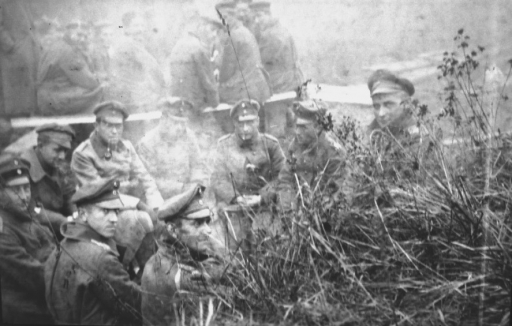Centenary News writer, Katherine Quinlan-Flatter, describes how her research into the life of a young German doctor at the Western Front has led her to rediscover an undeveloped film of the last days of the war in a German archive.
Since October 2013, I have been researching the letters of Dr. Theodor Kiefer, known to his friends and family as “Tor” and the son of Alexander Kiefer, a well-to-do architect and master mason in our small town of Ettlingen in Baden, South Germany.
These letters are held in our Town Archive in Ettlingen, but in October 2014 I discovered Tor’s own estate in a library in Speyer. It contains many fascinating articles and objects, but one of my most exciting finds to date has been two small packets of undeveloped negatives from the Western Front in 1918.
By the outbreak of the First World War, Tor’s older brother Oskar was already a renowned sculptor, who had created statues and monuments in various German and Swiss cities.
It is Oskar’s estate that is held in the Town Archive in Ettlingen, and it consists mainly of diaries, sketches and letters. A great many of these letters were written by Tor to his family from both the Eastern and the Western Fronts.
Because Tor was such an excellent reporter and because, as an officer, his letters were not censored, they provide tremendous insights to life at the Front, and contribute many details of historical and military significance.
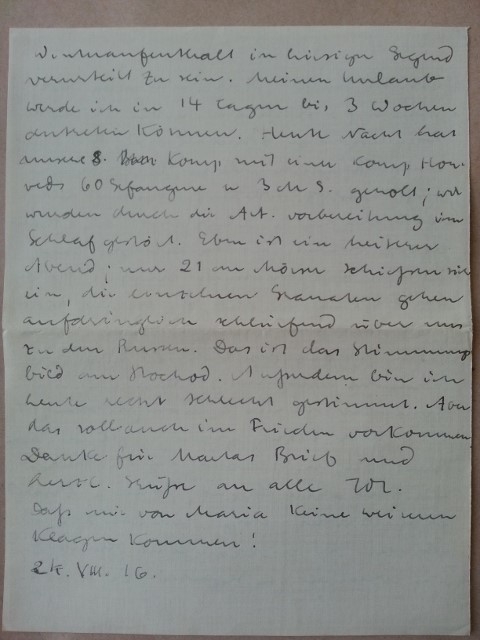
Tor’s Letter From The Eastern Front, 24/8/1916
Copyright Stadtarchiv Ettlingen
I had learned in 2013 that Tor’s estate itself had been bequeathed to an archive in the Rhineland-Palatinate, the state in which Tor’s adopted home city of Kaiserslautern is situated.
However, as Tor had died in 1985 at the age of 96, nobody could remember which archive actually held his estate. The town archivist of Ettlingen and I contacted every archive in the Rhineland-Palatinate without success, until I stumbled by chance on the Palatinate State Library in Speyer, which, it transpired, holds around 50 boxes of Tor Kiefer’s estate.
My first visit to the Library in Speyer was thrilling. It was the first time since Tor’s death in 1985 and the original categorisation by the Library that the boxes had been removed from the shelves and opened. Many of the contents were completely unresearched.
I continued to visit the Library regularly to research the contents of the boxes, and in December 2014 I discovered the two packets of around 20 individual negatives, 4.5 cm by 6.5 cm, which I could see were photos from the Front.
No developed photos of these negatives exist, and so I developed them myself using a smartphone app and a light table provided to me by the Library.
The results were mainly very good, although some of the negatives are a little damaged. Tor seemed to possess an excellent camera and most of the photos have an artistic touch, redolent of his creative family background.
The only drawback was that I initially had very little indication of the time or place where Tor had taken them.
However, together with a friend and the assistance of the Regimental Histories of the Reserve Infantry Regiments 249, 250 and 251 (to which Tor was assigned), written in the 1920s and 1930s, we have been able to find out the stories behind many of these photos. They span the last days of the War in 1918 at the Western Front and the march home of the German troops.
I have provided three examples here.
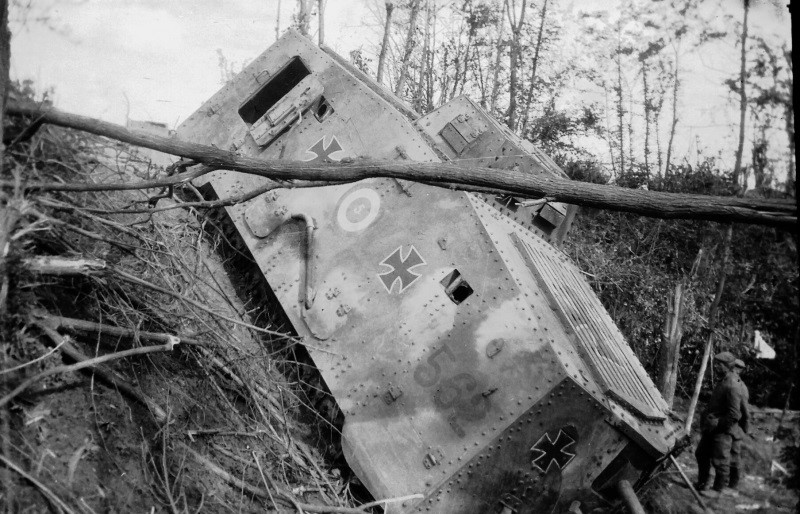
“Herkules”, A7V 562 by Tor Kiefer
Copyright Pfälzische Landesbibliothek Rheinland-Pfalz
The above photo is of the A7V tank “Herkules”, tank number 562. I found this out from the number of the tank which is clearly visible in the photo. Each A7V had a number and a name. This male tank of Panzerabteilung Nr. 1 toppled over and fell into a ditch on June 9, 1918 between Rollot and Courcelles-Epayelles at the Western Front. According to the Regimental History of the RIR 250, Herkules was not retrieved from the ditch until mid-July. Once this photo had been localised, we knew that the films had been shot in 1918.
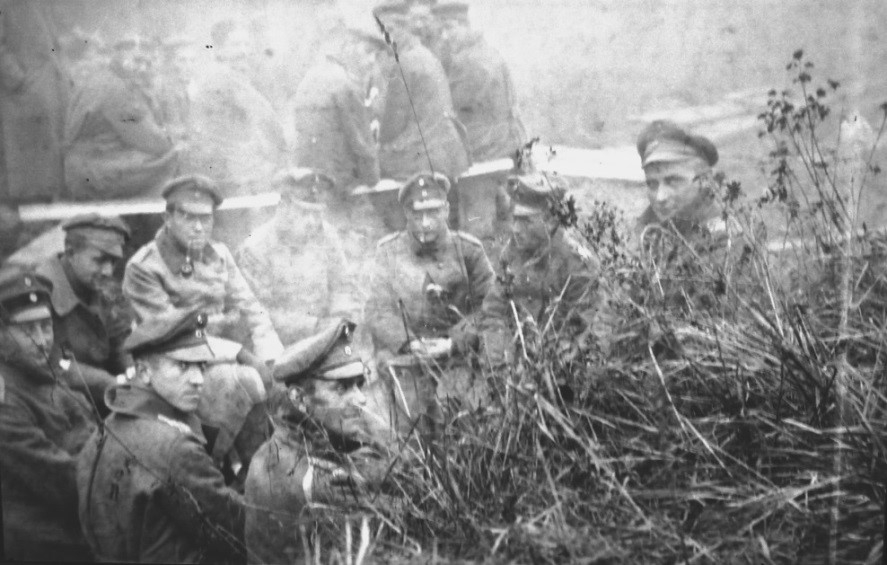
Around The Bonfire After The Ceasefire by Tor Kiefer
Copyright Pfälzische Landesbibliothek Rheinland-Pfalz
This photo shows officers in the foreground and men in the background around bonfires, one of several such photos taken by Tor. The Regimental Histories tell us that this November was extremely cold – in the mornings, the ground was frozen.
Following the ceasefire signals blown by buglers at around 11 o’clock French time on the morning of November 11, 1918, bonfires were lit all along the Front, states the Regimental History of the RIR 251. Tor, in his memoirs “The End Of The War”, which I also found in a box in the Library, writes: “Everywhere, matches blazed under wood that had been painstakingly gathered, and across the whole Line, one could see the small fires smoking”. Taking into account the resigned, unhappy expressions of the officers, it seems likely that Tor shot this photo shortly after the ceasefire signal.
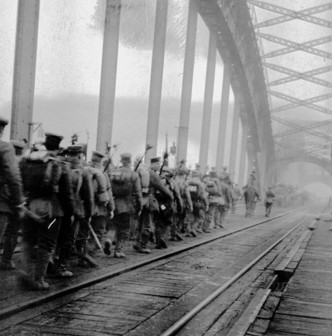
The March Home: The Kaiserbrücke At Mainz by Tor Kiefer
Copyright Pfälzische Landesbibliothek Rheinland-Pfalz
In this photo, the troops have flowers stuck onto the tops of their bayonets. We thus realised that the men were marching home. The Regimental Histories describe how the returning troops were greeted with flowers by the German population and shouts of “Our boys are coming!” (although, in some cases, they were attacked by young boys who ripped off their cockades and epaulettes in the streets).
The bridge, which my friend was able to identify from another old photo as the Kaiserbrücke at Mainz, looks completely different today. The Regimental History of the RIR 251 states that these troops marched over the Kaiserbrücke on November 30, 1918, to “thunderous jubilation” from the population of Mainz.
The film also includes other photos of the march home, many of which can be identified thanks to landmarks and scenery. Two photos show the troops at the bridge in Bingen, where the River Nahe meets the River Rhine and through which almost all returning German troops passed. I travelled to Bingen to try to reproduce this photo of the bridge, but my efforts were not as successful as Tor’s, who possessed both artistic talent and a far superior camera.
In addition, the film contains a photo of the bugler blowing the ceasefire signal. To our knowledge, it is the only photo of this kind that exists. Other photos show troops at rest in the field on the Western Front, dugouts, explosions at the Line and captured French prisoners.
These photos, together with Tor’s letters, memoirs and his books of sketches from the Western Front have enabled me to build up a more comprehensive picture of Tor’s life in the last stages of the War and afterwards, and to provide, to some extent, an in-depth study of both historical events and daily social life at the Front.
Copyright: Centenary News and Author
